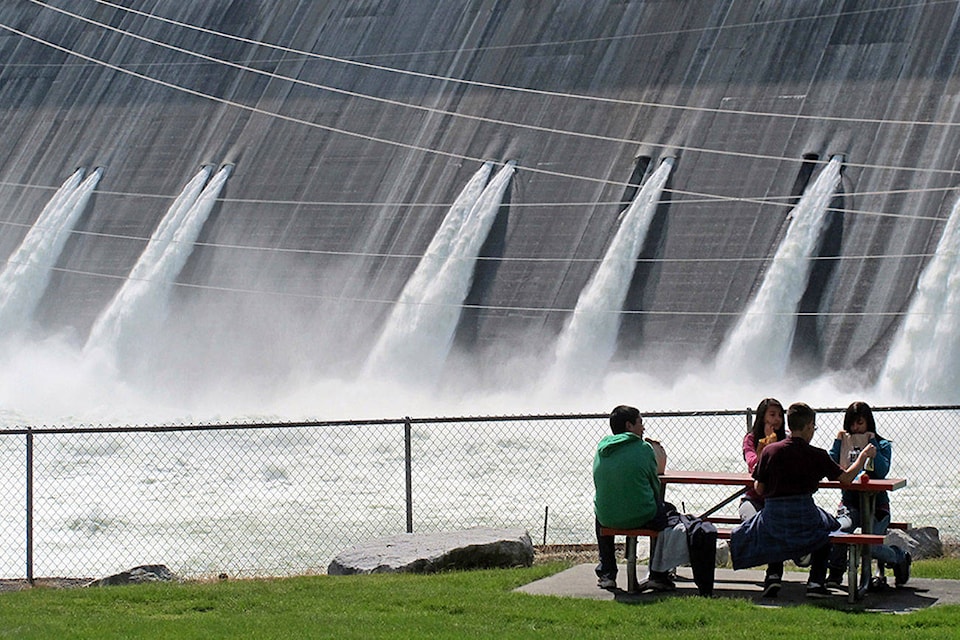Maps of the Columbia River circulating in the U.S. often stop at the international border, as though the world beyond is unknown. Rivers, forests, and wildlife do not recognize such borders. For thousands of years salmon returned to spawn along this undivided river. Indigenous people lived and buried their dead here.
That border along the 49th parallel was drawn by political leaders in London and Washington D.C., an artificial boundary for the river that we would do well to move beyond. Despite that straight-line boundary drawn over salmon and salmon people, the Upper Columbia in both the U.S. and Canada remains a region with shared and binding history, culture, and economy.
One tie that binds us together is reciprocal education. Community Colleges of Spokane and Selkirk College jointly hosted the sixth annual international conference, One River – Ethics Matter, in Castlegar last week.
Because of worsening forest fires and massive salmon die-offs from warming reservoirs, the conference focused on youth at risk, climate change, and renewing the Columbia River Treaty. Indigenous, religious, and academic leaders convened to discuss ethics, and the past and future of the Columbia and tributary rivers.
The Columbia River Basin is an international watershed the size of France. Only one-sixth is in Canada. Downstream at Astoria, Oregon, roughly 40 per cent of the river’s water flowing into the Pacific originates north of the border. In especially warm years with little snow, that number climbs toward 50 per cent. With climate change, the Columbia’s cold, water-rich north is increasingly valuable.
Just as tribes gathered at Kettle Falls to trade goods and fish for ocean salmon, people continue to engage in regional commerce. Canadians travel to and through Spokane, Colville, Sandpoint, Bonners Ferry, and many other communities. Many Americans travel north to experience the amazing beauty of British Columbia. Canadian and American flags fly side-by-side over many businesses. U.S. and Canadian dollars trade hands in a robust, regional border economy.
The Peace Arch at the border between the two countries is inscribed: “Children of a common mother,” symbolizing enduring friendship across a long international border. Here Canadian and American political leaders met in 1964 to complete the Columbia River Treaty.
The treaty authorized the construction of four major water storage dams — one in Montana and three in B.C., setting in place American-Canadian joint governance of the international Columbia River. Building these dams and reservoirs required logging, bulldozing and flooding vast wildlife and fisheries-rich forested valleys of the Upper Columbia. Hugh Keenleyside Dam, near Castlegar, forced 2,300 people from their homes.
The Columbia River Treaty manages for two purposes only: hydropower and flood risk. The treaty is silent on health of the river, riparian habitat, survival of salmon and salmon-based cultures, and Indigenous sovereignty. Once 16 million to 30 million salmon returned to the Columbia River Basin annually. Under the current treaty, the river is managed as a machine that generates wealth for some at costs to others.
Treaty negotiations began a year ago. Much is at stake for the Upper Columbia on both sides of the border. Negotiations are closed to the public.
Regional citizens, acting as a “community of the Columbia,” are striving to influence their destiny through learning about and urging that an updated international river treaty get right what the original treaty got wrong. Health of the river — “ecosystem-based function,” including restoring salmon above Grand Coulee dam — needs to be added as a third treaty purpose co-equal with hydropower and flood risk. The river needs a voice.
“If you are not at the table, then you’re on the menu.” Canada has invited First Nations into the treaty negotiation sessions as observers. We remain hopeful that American negotiators will also invite aboriginal Columbia Basin tribes.
Against a backdrop of historic wrongs and unfolding climate change, stewardship and justice-based river governance is within our grasp. Water is fundamental. Water is life.
As the Indigenous tribes who speak Syilx, one of the Columbia’s Indigenous languages, have memorialized in their Water Declaration, “When we take care of the land and water, then land and water take care of us. This is our law.”
Mindy Smith, MD, MS is a family physician and medical editor who works with Citizens for a Clean Columbia advocating for the Columbia River ecosystem. The Rev. Martin Wells is the retired Lutheran bishop for the Eastern Washington, Idaho, and Wyoming Synod of the Evangelical Lutheran Church in America.
